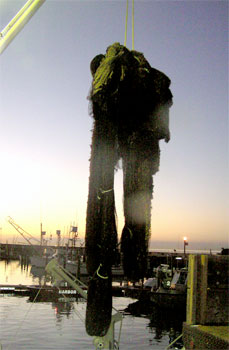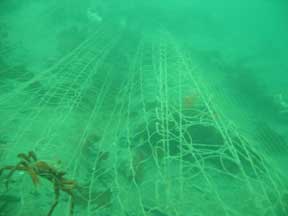 Lost and abandoned underwater fishing gear can be dangerous to wildlife as well as people. Derelict nets in particular can entrap fish, sharks and marine mammals, but also divers. That’s why locals are cheering the new University of California at Davis program that scooped up nearly 10 tons of lost and abandoned fishing gear from the waters around the Channel Islands in their first year of operating. Scuba divers removed hundreds of commercial lobster traps, fishing rods, sport traps, and a huge tangle of fishing net covering 5,000 square feet of sea floor…
Lost and abandoned underwater fishing gear can be dangerous to wildlife as well as people. Derelict nets in particular can entrap fish, sharks and marine mammals, but also divers. That’s why locals are cheering the new University of California at Davis program that scooped up nearly 10 tons of lost and abandoned fishing gear from the waters around the Channel Islands in their first year of operating. Scuba divers removed hundreds of commercial lobster traps, fishing rods, sport traps, and a huge tangle of fishing net covering 5,000 square feet of sea floor…
No one had any idea that the California Derelict Fishing Gear Removal Project would find and remove as much gear as they did. Similar projects in Washington and Hawaii have removed hundreds of tons of derelict fishing gear, but this is the first such program in California.
An important goal of the UC Davis project was to work cooperatively with fishermen to locate the derelict gear and establish volunteer reporting among the fishing and maritime communities. Now, anyone who loses fishing gear or observes derelict fishing gear underwater is encouraged to report their sighting by calling 1-888-491-GEAR or filling out a reporting form available online at www.derelictfishinggear.org.
 The project hired commercial fishermen Mark Brubaker and Kenny Hill of Santa Barbara and Mike Neil of San Diego to conduct the cleanup. Volunteer scientific divers from Long Beach Aquarium of the Pacific and Humboldt State University joined them and helped test field-survey methods.
The project hired commercial fishermen Mark Brubaker and Kenny Hill of Santa Barbara and Mike Neil of San Diego to conduct the cleanup. Volunteer scientific divers from Long Beach Aquarium of the Pacific and Humboldt State University joined them and helped test field-survey methods.
Of almost 550 pieces of fishing equipment collected in five weeks of work, many were reusable commercial lobster traps. With traps costing $60 to $100 each, Gilardi said, the recovery work saved California lobster fishermen at least $6,000 in materials costs.
The lost lobster traps that had been carried away by storms or run over by boats had been fitted with trap door devices that would eventually disintegrate underwater to protect lobsters who may be trapped inside. Of the derelict traps recovered in this project, some of those collected soon after the close of the commercial lobster season contained live lobsters. Whereas all the traps collected several months post-season were open and empty, which indicated the safety-release system is working.
Between May and October, the fishermen used scuba equipment and an underwater scooter to locate and recover derelict fishing gear in 20 to 100 feet of water around Santa Rosa, Santa Cruz, Anacapa and Santa Catalina islands. When encountering debris, they raised it to the surface with float bags and winches, then took it to shore by boat. Once on shore, reusable material was returned to commercial fishermen.
The huge fishing net was a purse seine net — the type used to catch anchovies or sardines. It weighed 4,000 pounds and was snagged on a rocky reef in 80 to 100 feet of water at the eastern end of Santa Rosa Island.
The pilot project was funded by California’s Ocean Protection Council through the California State Coastal Conservancy, and by the National Oceanic and Atmospheric Administration (NOAA) Marine Debris Program. The work received significant support (including onshore storage, docking privileges and air-tank refills) from Two Harbors Dive Shop on Santa Catalina Island, Jankovich & Son Fuel Dock in San Pedro, and the City of Santa Barbara Waterfront Department.
The Channel Islands National Marine Sanctuary and its national park authorized the work. The project is managed by the SeaDoc Society, a marine ecosystem health program of the UC Davis Wildlife Health Center.



















